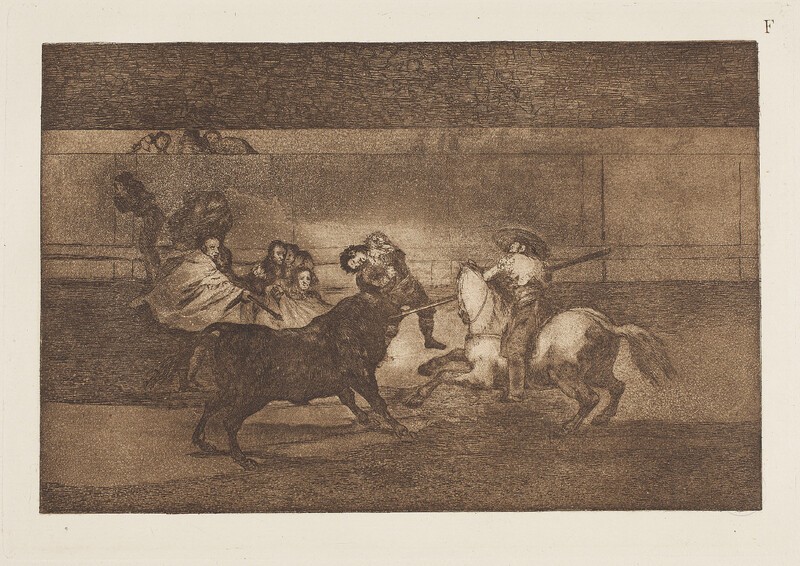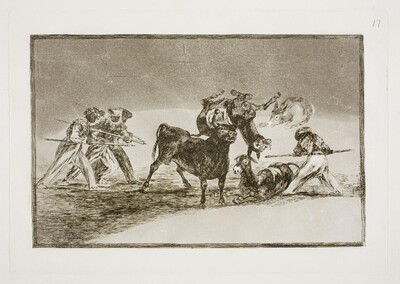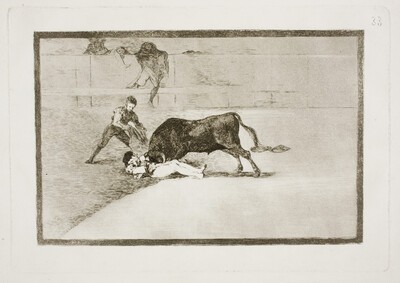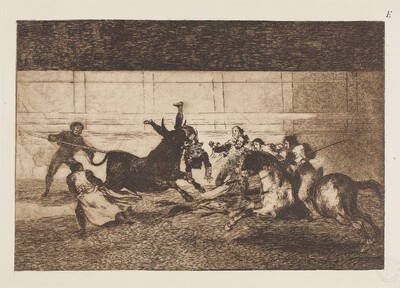- Cronología
- 1814 - 1815
- Dimensiones
- 245 x 349 mm
- Técnica y soporte
- Aguafuerte, aguatinta, punta seca, buril y bruñidor
- Reconocimiento de la autoría de Goya
- Documented work
- Ficha: realización/revisión
- 03 Oct 2021 / 22 Jun 2023
- Inventario
- -
- Otros títulos:
-
F (print, upper right-hand corner)
Goya (print, bottom right-hand corner)
See How the ancient Spaniards hunted bulls on horseback in the countryside
The print, rejected by Goya and not included in the first edition of the Bullfighting of 1816, was added and published for the first time, along with six other (A-G), in the third edition of the series, published by Eugène Loizelet in Pais in 1876. It was retained in subsequent editions of the Bullfighting.
A proof of the state before the additional aquatint and another proof of the same state stamped on the reverse of the previous proof are preserved. Both proofs, from the Carderera Collection, are kept in the National Library of Spain, Madrid (Inv. 45679)
The plate is kept at the National Chalcography (nº 372), with Palenque of the Moors made with donkeys to defend themselves from the bull charged with a bull engraved on the obverse.
See How the ancient Spaniards hunted bulls on horseback in the countryside
Following the order established by Loizelet in 1876, this is the third of the three scenes (33, E and F) dedicated by Goya to the death of the bullfighter Pepe Illo in the bullring in Madrid on 11 May 1801, reflecting different moments of his mortal injury. In this case we see a moment somewhat later than the one in the immediately preceding picture, entitled The Death of Pepe Illo ( Bullfighting E), as we can see how the bull, after the initial goring in the bullfighter's thigh and his being thrown into the air as shown in that picture, has already impaled the bullfighter in the stomach, a mortal wound of necessity which will be what really causes his death twenty minutes after he suffers it.
We can see that the bullfighter, while being impaled, is holding the bull's horn with one hand, as if trying to free himself, but he looks like a wimp. Just in front of the bull is a picador on horseback, also present in the previous image, who is thrusting his pike into the bull's neck in an attempt to get him to leave the bullfighter. Just behind the main group we see several young men, already present in the preceding engraving, whipping the bull to make him release the bullfighter. In the background we can make out a couple of people holding their faces and turning their faces away from the spectacle, the barrier of the bullring, and the audience in the stands, which cannot be made out as they are only sketched out.
The only point of light in the scene is in the centre of the composition, illuminating the picador, the injured bullfighter and some of the members of his gang who are trying to help him. The print shows perfectly the grain of the aquatint.
Beruete points out that the print has little chiaroscuro, is uniform and somewhat blurred, and lacks the general blotchy effect so frequent in the series. Lafuente Ferrari, for his part, interprets the engraving as a variant of The Death of Pepe Illo ( Bullfighting E) with improved composition and lighting.
Gassier compares the preparatory drawing with the final engraving and points out that the pathos is increased here in the print by the number of figures included and by the final composition used, with the figures grouped together in the centre of the scene.
Martínez-Novillo highlights the quality of the three prints that tell the story of the death of Pepe Illo. In fact, he considers that Goya was satisfied with his work because he did not destroy his plates and signed them, although he only included one in the first edition of the Bullfighting. In his opinion, Goya finally chose to show the simplest view of Pepe Illo's death, which is why he decided on The Unfortunate Death of Pepe Illo in the Madrid Square.
It is also worth noting that Goya dedicated another print in Bullfighting to Pepe Illo, very different from the previous ones, as it focuses on his great skills as a bullfighter although it also alludes to his tendency towards recklessness: Pepe Illo cutting the bull.
There is a preparatory drawing for this print, also entitled The death of Pepe Illo (Bullfighting F)
-
Grabados y dibujos de Goya en la Biblioteca NacionalBiblioteca NacionalMadrid1946catalogue Elena Páez Ríos
-
Goya en la Biblioteca Nacional. Exposición de grabados y dibujos en el sesquicentenario de su muerteBiblioteca NacionalMadrid1978May - June 1978
-
Grabados de Goya: colección propiedad de la Biblioteca Nacional, que se conserva en su Gabinete deCasa de la Amistad de MoscúMoscow1979exhibition displayed from January 18th to 31st 1979
-
1984
-
Madrid1990
-
Goya grabadorFundación Juan MarchMadrid1994consultant editors Alfonso E. Pérez Sánchez and Julián Gállego, from January 14th to March 20th 1994
-
Goya grabadorMuseo del Grabado Español ContemporáneoMarbella1996from March 8th to May 5th 1996
-
Ydioma universal: Goya en la Biblioteca NacionalBiblioteca NacionalMadrid1996from September 19th to December 15th 1996cat. 271
-
Schlaf der Vernunft. Original radierungen von Francisco de GoyaMunich2000
-
Madrid2002
-
Madrid2002
-
Bilbao2012
-
Zaragoza2017
-
MadridBlass S.A.1918p. 139
-
1946pp. 177-216, espec. pp. 212-213
-
BarcelonaTartessos-F. Oliver Branchfelt1946 (reed. 1951)
-
OxfordBruno Cassirer1964vol. II, 1964, p. 356, cat. 242
-
Vie et ouvre de Francisco de GoyaParísOffice du livre1970p. 280, cat. 1229
-
The Changing image: Prints by Francisco GoyaBostonMuseum of Fine Arts1974pp. 244-247, cat. 196
-
MilwakeeMilwaukee Art Museum1986pp. 19 y 28
-
Goya, toros y torerosMadridMinisterio de Cultura, Comunidad de Madrid1990pp. 122-123, cat. 57
-
MadridCaser-Turner1992pp. 37 y 39
-
Catálogo de las estampas de Goya en la Biblioteca NacionalMadridMinisterio de Educación y Cultura, Biblioteca Nacional1996cat. 366
-
Ydioma universal: Goya en la Biblioteca NacionalMadridBiblioteca Nacional, Sociedad Estatal Goya 96 y Lunwerg1996pp. 244-245
-
MadridMuseo Nacional del Prado2001pp. 105-106
-
Goya. In the Norton Simon MuseumPasadenaNorton Simon Museum2016pp. 186-201





